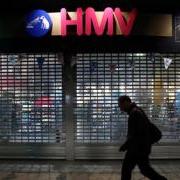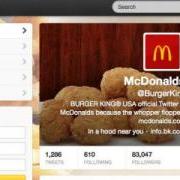By Nick Johnson - February 20th, 2013
A look at social media crisis response- considering stories around HMV, Burger King and Tesla that have been in the news recently. We look atan innovative SoLoMo campaign from Topshop, too - and more!
Hello all,
Welcome back to this week's installment of all that's critical in the world of corporate social media. Somewhat unsurprisingly, we're focusing on crisis response this week - but we also have some interesting news from London Fashion Week, and some new research on how brands are using influencers. Read on.
Social media + Mistakes = Fast-brewing crisis

There have been more brand crises over social media than I care to remember. There are always different causes (disgruntled/badly trained staff; lack of transparency; lack of response; controversial offline decision-making coming home to roost online), but one thing that always happens is that when social media gets involved, the problem tends to get worse.
It doesn't have to be this way. Social offers a pretty fantastic engagement channel, and for the company that's prepared, and that has some strategic thinking done on social media/reputation preservation, it can act as both a salve to angry stakeholders and an early-warning system of looming issues.
But. hey, when you allow interns to run your social media presence, things are going to go wrong. Hello HMV. For those of you that don't know, HMV is currently in administration, and is getting rid of a lot of staff. Unsurprisingly, tensions are running high. Fortunately for those interested, but really rather unfortunately for those interested in preserving HMV's brand, a young intern 'live tweeted' the 'mass execution' of loyal workers, and a lot more. Best quote: "Just overheard our Marketing Director (he's staying, folks) ask 'How do I shut down Twitter?'". Oh dear.
Ryan Holmes, CEO of Hootsuite, has written in Fast Company about lessons learned. A potted list is below, and focuses on ownership of social presences:
- Centralise social channels (there are LOADS of channels at most companys. Spot them, and then manage them)
- Don't let everyone tweet (OBVIOUSLY don't give everyone access to tweet on your behalf from corporate accounts. Ryan talks about the unique abilities his product offers to solve this problem. I have a simpler one. Code of Conduct. Simple, clear, signed).
HMV's brand people will be thrilled to know they weren't the only social media crisis this week. Burger King also lost control of their Twitter account. Slightly more sympathy for them, considering hackers broke in and took control (assuming their password wasn't 'password'). The hackers changed the corporate avatar to McDonald's, and tweeted all manner of offensive images and messages.

Burger King, however, did pretty well to get a handle on the situation. The account was shut down within a couple of hours, and by the end of the day the company was back tweeting, making reference to the day's events. Transparency and speed of response. Both critical, and both used by BK to great effect. Not only that, BK now have 60,000 more followers than they did previously. Not all bad...
The ingredients of a great Online/Offline integrated campaign: Topshop/Google+

Topshop have always used social media very well, and in something of a coup for Google+, the clothing brand are using the network to co-ordinate their social outreach for London Fashion Week 2013.
The 2013 campaign has been called "A new kind of fashion show" - we would go further, and call this a case study for fantastic, comprehensive leveraging of social opportunities for better engagement, more customer alignment, brand outreach and reputation enhancement.
Topshop have quite helpfully created a video outlining their work this year - check it out here. #
Seen it? Good. So that's HOW the campaign worked. But WHY did it work? There are 4 key reasons, it seems to me:
- Real value offered to a target demographic: One of the strengths of Topshops's campaign is that they know exactly who they're wanting to target - young, fashion conscious females. They're therefore able to offer these guys some clear value through the campaign. They offer exclusive content ("Behind the Scenes Access" and model diaries from some of the more famous models involved in the show) that is actually worth something to the audience - and crucially, aligned to the brand.
- Genuine engagement opportunities for deeper relationships: Too often social campaigns claim to offer extensive engagement, but fall short. Not Topshop. This year, they've allowed customers to "Be The Buyer" - curate and share their own version of the Topshop collection. Not only is this something that deepens engagement with the products being pushed, but it gives Topshop fantastically useful data on which product appeals to which consumer. If they're not doing follow up target marketing based on the info gathered, they're missing a trick.
- Online/Offline integration: As hard as it tries, Google+ isn't exactly the place to be for young, fashion conscious females yet. Topshop could have been shouting about LFW in an empty room. But they weren't. They'd already built the social engagement opportunities into their offline presences - their stores. A "Be The Model" booth was installed in their flagship Oxford St store, allowing customers to virtually try on clothes from the collection and then share the results. Suddenly, the core audience for the company's efforts was not only learning about the campaign but actively promoting it to others in the same demographic.
There's a great, more extensive rundown on this campaign over at Fast Company.
Marketers, meet influencers: You've got to get along
Technorati have just released their "2013 Digital Influence Report", and ReadWriteWeb have done a great summary. The main message? Brands are not doing very well at engaging influencers.
While 86% of key influencers are using blogs as their main publishing channel, only 11% of social media budgets are used to get presences here. Companys are still enamoured by Facebook ads (57% of budget) and sponsored tweets (13%).
Influencers are not tending to use social media to engage - they're using it to promote their work and drive people back to their blogs. And yet companys have things the other way around.
Influencer engagement is a proven method to improve corporate social media impact, and yet most brands aren't engaging in the place the influencers operate.
Have a read of the article, and let us know what you think.
Bonus Content: CMOs/VPs from Sears, Wells Fargo and Thomson Reuters on how to embed social
Last week, we ran our first webinar - looking at a critical topic for 2013 - the best ways to embed social across your business. We had a great line-up of contributors (CMO of Sears, VP of Social at Wells Fargo and Senior Director of Social at Thomson Reuters), some fantastic insights and great discussion with our participants.
Some of the key learnings:
- "Content gives us the opportunity to have a great conversation - and collaborate i social. Without that content, people aren't going to engage with us as a brand, nor are they going to repeatedly visit our site" - Jennifer Dominiquini, CMO, Sears
- Practitioners have got to start using more detailed metrics to track impact, and get beyond follower numbers. It's imperative that you know the effect of social activity on reputation, marketing, sales and customer satisfaction
- 'Social Business' can be defined as "people being the brand, doing their jobs better and with greater efficiency" according to Jen McClure, Senior Director of Social at Thomson Reuters.
Maybe you missed it?
Well, no worries. You can listen to the 45m audio recording of the whole webinar, along with a fuller summary of the key findings, for free, here.
That's all for this week. If you can't bear to wait that long, make sure you follow us on Twitter, Facebook and Google+.
Next Reads
June 2014, New York
Become a social business: For superior marketing response, sharper corporate decision-making, enhanced innovation and a happier, more loyal customer
Brochure Programme